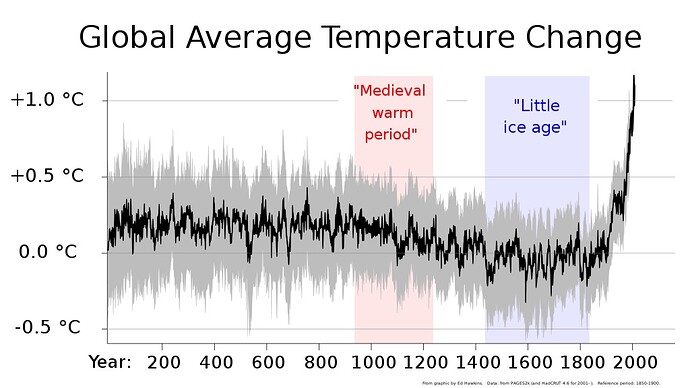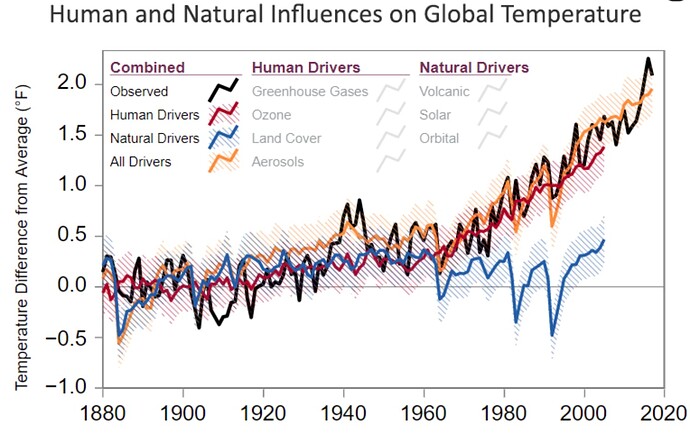Well, there’s a lot of nuance to how that should be answered. Climate variability has been around for as long as the earth has existed. And, timescales, and our existence within those timescales matter. For context; this is the climate trend in the last 420,000 years:

The current spike remains below “historical norms”. Think of dinosaurs roaming the tropical high latitudes in northern Canada as an example of how far we still have to potentially go. It is likely to continue to go up (overall) in response to the 3 main natural contributors to climate change: changes in the sun’s energy output, regular changes in the earth’s orbital cycle and large volcanic eruptions that dump particulates into the stratosphere with fluctuations in that overall mean slope increase.
Next is the change over the last 20,000 years or so since the last ice age. See that little spike right at the end? That’s us.
Last, here’s that spike in isolation over the last 2,000 years:
You see the natural variation in the overall slope mean increase very well here. There had been a natural flattening of the rise after the last ice age in response to changing sun energy outputs and then a short-term (~500 years) downward trend in temps due to a series of massive volcanic eruptions. The one thing that clearly jumps out is the sharp increase starting with the advent of the industrial revolution. That is very clearly us and is based on 3 main (and a number of minor contributing) factors: the burning fossil fuels, cutting down forests and farming livestock.
This graph shows the separation of natural and human forcing agents on the current upward spike. It’s pretty telling:
So, we are indeed having an impact on an already upward trend. One of the questions we have to ask ourselves is; is this a problem? We, as humans, tend to want things to stay the same. We crave the predictability that sameness provides. Yet, we live on a highly variable planet and our success, as a species, is based our our fantastic ability to adapt. So, I think the right question is not “what can be done to stop it”, it’s “what should we be doing with the limited resources we have”. Which leads to:
One of the other nuances is; should we even try to stop it? Doing so outside of the normal and expected advantageous advances in technology that are likely to move humanity away from fossil fuel use and its subsequent contribution to greenhouse gasses would be prohibitively expensive and ignore many of the key drivers of human behavior. If we, as a species, choose to devote the resources necessary to halt or reverse ageotropic human forcing on the climate (trillions of $$), it will come at a cost to other important areas: healthcare, housing, wealth generation, leisure, etc… Humans have shown time and again that making such long-term investments are not realistic, especially when the impact on their daily lives is immediate. We’ve also show that we will repeatedly make sort-term, self serving decisions that are at direct odds with the available weather data, even risking short-term wellness. Massive human living/working development in Tornado Alley is one. Massive development along Hurricane-prone areas is another. Given the backdrop that, with the current rate of technological change underway, our current destructive ageotropic impact is self-correcting, I just don’t see it happening. The question is, how bad will it get before those enabling technology changes take place and how much disruption will humanity have to endure. If the course of human history is any indication, the answer to both of those things is “quite high” but that is tempered by the fact that that history shows that humans are one of the most adaptable species to ever inhabit this planet. Yes, seas will rise. Yes, coastal communities will have to relocate. Yes, it’ll get less habitable in some places and more habitable in others and people will migrate in response. Just as has happened throughout the course of human history. So, I am inclined to say we should let the natural course of rapid technological advancement continue, which will ameliorate the need for fossil fuels, will lead the the generation of lab-grown meats and animal products and will lead to reforestation, just like is happening in Europe.




